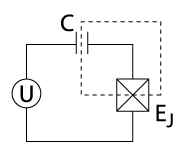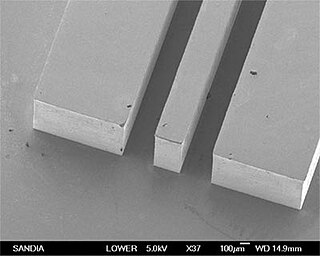This is a timeline of quantum computing.
In logic circuits, the Toffoli gate, also known as the CCNOT gate (“controlled-controlled-not”), invented by Tommaso Toffoli, is a CNOT gate with two control qubits and one target qubit. That is, the target qubit will be inverted if the first and second qubits are both 1. It is a universal reversible logic gate, which means that any classical reversible circuit can be constructed from Toffoli gates. Formally, we describe the Toffoli gate with the following truth table and matrix:
Quantum error correction (QEC) is a set of techniques used in quantum computing to protect quantum information from errors due to decoherence and other quantum noise. Quantum error correction is theorised as essential to achieve fault tolerant quantum computing that can reduce the effects of noise on stored quantum information, faulty quantum gates, faulty quantum state preparation, and faulty measurements. Effective quantum error correction would allow quantum computers with low qubit fidelity to execute algorithms of higher complexity or greater circuit depth.

In quantum computing, a charge qubit is a qubit whose basis states are charge states. In superconducting quantum computing, a charge qubit is formed by a tiny superconducting island coupled by a Josephson junction to a superconducting reservoir. The state of the qubit is determined by the number of Cooper pairs that have tunneled across the junction. In contrast with the charge state of an atomic or molecular ion, the charge states of such an "island" involve a macroscopic number of conduction electrons of the island. The quantum superposition of charge states can be achieved by tuning the gate voltage U that controls the chemical potential of the island. The charge qubit is typically read-out by electrostatically coupling the island to an extremely sensitive electrometer such as the radio-frequency single-electron transistor.
Superconducting quantum computing is a branch of solid state quantum computing that implements superconducting electronic circuits using superconducting qubits as artificial atoms, or quantum dots. For superconducting qubits, the two logic states are the ground state and the excited state, denoted respectively. Research in superconducting quantum computing is conducted by companies such as Google, IBM, IMEC, BBN Technologies, Rigetti, and Intel. Many recently developed QPUs use superconducting architecture.
A quantum bus is a device which can be used to store or transfer information between independent qubits in a quantum computer, or combine two qubits into a superposition. It is the quantum analog of a classical bus.
In quantum computing, and more specifically in superconducting quantum computing, the phase qubit is a superconducting device based on the superconductor–insulator–superconductor (SIS) Josephson junction, designed to operate as a quantum bit, or qubit.

In quantum computing, and more specifically in superconducting quantum computing, a transmon is a type of superconducting charge qubit designed to have reduced sensitivity to charge noise. The transmon was developed by Robert J. Schoelkopf, Michel Devoret, Steven M. Girvin, and their colleagues at Yale University in 2007. Its name is an abbreviation of the term transmission line shunted plasma oscillation qubit; one which consists of a Cooper-pair box "where the two superconductors are also [capacitively] shunted in order to decrease the sensitivity to charge noise, while maintaining a sufficient anharmonicity for selective qubit control".
In quantum mechanics, the cat state, named after Schrödinger's cat, refers to a quantum state composed of a superposition of two other states of flagrantly contradictory aspects. Generalizing Schrödinger's thought experiment, any other quantum superposition of two macroscopically distinct states is also referred to as a cat state. A cat state could be of one or more modes or particles, therefore it is not necessarily an entangled state. Such cat states have been experimentally realized in various ways and at various scales.

Coplanar waveguide is a type of electrical planar transmission line which can be fabricated using printed circuit board technology, and is used to convey microwave-frequency signals. On a smaller scale, coplanar waveguide transmission lines are also built into monolithic microwave integrated circuits.

Robert J. Schoelkopf III is an American physicist, most noted for his work on quantum computing as one of the inventors of superconducting qubits. Schoelkopf's main research areas are quantum transport, single-electron devices, and charge dynamics in nanostructures. His research utilizes quantum-effect and single-electron devices, both for fundamental physical studies and for applications. Techniques often include high-speed, high-sensitivity measurements performed on nanostructures at low temperatures. Schoelkopf serves as director of the Yale Center for Microelectronic Materials and Structures and as associate director of the Yale Institute for Nanoscience and Quantum Engineering. Since 2014, Schoelkopf is also the Director of the Yale Quantum Institute. He is Professor of Physics and Sterling Professor of Applied Physics at Yale University. The title of Sterling Professor is the highest honor bestowed upon Yale faculty.

Michel Devoret is a French physicist and F. W. Beinecke Professor of Applied Physics at Yale University. He also holds a position as the Director of the Applied Physics Nanofabrication Lab at Yale. He is known for his pioneering work on macroscopic quantum tunneling, and the single-electron pump as well as in groundbreaking contributions to initiating the fields of circuit quantum electrodynamics and quantronics.

Irfan Siddiqi is an American physicist and currently a professor of physics at the University of California, Berkeley and a faculty scientist at Lawrence Berkeley National Laboratory (LBNL).

Andreas Wallraff is a German physicist who conducts research in quantum information processing and quantum optics. He has taught as a professor at ETH Zürich in Zürich, Switzerland since 2006. He worked as a research scientist with Robert J. Schoelkopf at Yale University from 2002 to 2005, during which time he performed experiments in which the coherent interaction of a single photon with a single quantum electronic circuit was observed for the first time. His current work at ETH Zürich focuses on hybrid quantum systems combining superconducting electronic circuits with semiconductor quantum dots and individual Rydberg atoms as well as quantum error correction with superconducting qubits.
In quantum computing, a qubit is a unit of information analogous to a bit in classical computing, but it is affected by quantum mechanical properties such as superposition and entanglement which allow qubits to be in some ways more powerful than classical bits for some tasks. Qubits are used in quantum circuits and quantum algorithms composed of quantum logic gates to solve computational problems, where they are used for input/output and intermediate computations.
Quantum volume is a metric that measures the capabilities and error rates of a quantum computer. It expresses the maximum size of square quantum circuits that can be implemented successfully by the computer. The form of the circuits is independent from the quantum computer architecture, but compiler can transform and optimize it to take advantage of the computer's features. Thus, quantum volumes for different architectures can be compared.
Randomized benchmarking is an experimental method for measuring the average error rates of quantum computing hardware platforms. The protocol estimates the average error rates by implementing long sequences of randomly sampled quantum gate operations. Randomized benchmarking is the industry-standard protocol used by quantum hardware developers such as IBM and Google to test the performance of the quantum operations.
Andrew A. Houck is an American physicist, quantum information scientist, and professor of electrical and computer engineering at Princeton University. He is director of the Co-Design Center for Quantum Advantage, a national research center funded by the U.S. Department of Energy Office of Science, as well as co-director of the Princeton Quantum Initiative. His research focuses on superconducting electronic circuits to process and store information for quantum computing and to simulate and study many-body physics. He is a pioneer of superconducting qubits.







